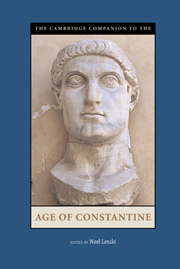Book contents
- Frontmatter
- Introduction
- 1 Sources for the History of Constantine
- Section 1 Politics and Personalities
- Section II Religion and Spiritual Life
- Section III Law and Society
- 8 Bureaucracy and Government
- 9 Civil Law and Social Life
- 10 Economy and Society
- Section IV Art and Culture
- Section V Empire and Beyond
- Appendix 1: Stemmata
- Appendix 2: Timeline
- Maps
- Primary Sources and Translations
- Secondary Bibliography
- Index
8 - Bureaucracy and Government
from Section III - Law and Society
Published online by Cambridge University Press: 28 September 2007
- Frontmatter
- Introduction
- 1 Sources for the History of Constantine
- Section 1 Politics and Personalities
- Section II Religion and Spiritual Life
- Section III Law and Society
- 8 Bureaucracy and Government
- 9 Civil Law and Social Life
- 10 Economy and Society
- Section IV Art and Culture
- Section V Empire and Beyond
- Appendix 1: Stemmata
- Appendix 2: Timeline
- Maps
- Primary Sources and Translations
- Secondary Bibliography
- Index
Summary
On September 18, 324, at Chrysopolis, just across the water from Byzantium, Constantine’s army won a decisive battle. This victory over the emperor Licinius (who had ruled most of the eastern half of the empire since 313) established Constantine’s control over a reunified Roman world. It effectively doubled his domains. But like all military successes - no matter how glorious or divinely inspired - the reconquest of the eastern Mediterranean posed a series of difficulties: practical, political, administrative, economic, and ideological. This chapter looks at one particular problem which might confront any government attempting to assimilate a large and recently subdued territory. The challenge Constantine and his advisers faced was, of course, not how to “Romanise” or “civilise” the eastern provinces - the very idea would have seemed farcical - but rather how to control and exploit its resources. One tactic was to strengthen the apparatus of central government control. The evidence is patchy and unsatisfactory, but it does seem that both after the victory at the battle of the Milvian Bridge in 312 (which confirmed Constantine’s rule in the west) and especially following the defeat of Licinius, a series of reforms significantly altered the duties of the empire’s most important civil and military officials. These innovations saw the consolidation and systematisation of distinct areas of responsibility under the supervision of high-ranking office-holders closely associated with the emperor himself.
- Type
- Chapter
- Information
- The Cambridge Companion to the Age of Constantine , pp. 183 - 204Publisher: Cambridge University PressPrint publication year: 2005
- 5
- Cited by

